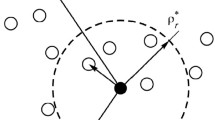Abstract
We consider a possible evaluation of frame-based nonstationary pattern recognition methods by using the upper bound trajectories of the Bayes error based on the Bhattacharrya distance. The experimental part of the work is based on natural speech processing, using isolated spoken Serbian vowels and digits as examples of nonstationary signals. The results obtained justify the use of the upper bound trajectories of the Bayes error expressed by the Bhattacharyya distance as a possible evaluation tool for the class of frame-based nonstationary pattern recognition systems.
Similar content being viewed by others
References
A. Bhattacharyya, On a measure of divergence between two statistical populations defined by their probability distributions,Bull. Calcutta Math. Soc., 35, 99–110, 1943.
Lj. Buturović and M. Marković, Improvingk-nearest neighbor Bayes error estimates, inProc. of 11th IAPR Intern. Conf. on Pattern Recognition, The Hague, The Netherlands, August 30–September 3, 1992.
H. Chernoff, A measure of asymptotic efficiency for tests of a hypothesis based on the sum of observations.Ann. Math. Statist., 23, 493–597, 1952.
K. Fukunaga,Introduction to Statistical Pattern Recognition, Academic Press, New York, 1990.
K. Fukunaga and D. Hummels, Bayes error estimation using Parzen andk-NN procedures,IEEE Trans. PAMI, vol. PAMI-9, 634–643, 1987.
D. Gutfinger and J. Sklansky, Robust classifiers by mixed adaptation,IEEE Trans. PAMI, vol. 13, no. 6, 552–567, June 1991.
B. Bovačević, M. Milosavljević, and M. Veinović, Robust recursive AR speech analysis,Signal Process., vol. 44, 125–138, 1995.
L. Ljung,System Identification: Theory for the User, Prentice-Hall, Englewood Cliffs, NJ, 1987.
M. Marković, B. Kovačević, and M. Milosavljević, A statistical pattern recognition approach to robust recursive identification of non-stationary AR model of speech production system,IEEE Trans. Speech Audio Process., vol. 4, no. 6, 456–460, November 1996.
M. Marković, M. Milosavljević, and B. Kovačević, Clustering in non-stationary pattern recognition systems,Signal Processing VII: Theories and Applications, edited by M. Holt, C. Cowan, P. Grant, and W. Sandham, European Association for Signal Processing (Proc. of EUSIPCO-94, Edinburgh, Scotland, 13–16 September 1994), pp. 1803–1806.
M. Milosavljević and I. Konvalinka, The modified generalized likelihood ratio algorithm (MGLR) for automatic detection of abrupt changes in stationarity of signals,Proc. of the 22nd Annual Conference on Information Science and Systems, Princeton, NY, 1988.
M. Veinović, B. Kovačević, and M. Milosavljević, Robust non-recursive AR speech analysis,Signal Process., vol. 37, no. 2, 189–201, May 1994.
Author information
Authors and Affiliations
Rights and permissions
About this article
Cite this article
Marković, M., Milosavljević, M. & Kovačević, B. On evaluating A class of frame-based nonstationary pattern recognition methods using bhattacharyya distance. Circuits Systems and Signal Process 19, 467–485 (2000). https://doi.org/10.1007/BF01196159
Received:
Revised:
Issue Date:
DOI: https://doi.org/10.1007/BF01196159




